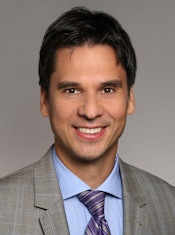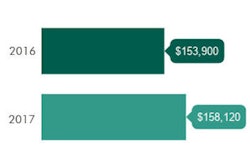
Earnings for general dentists have significantly increased for the first time in about 17 years, according to new data from the ADA Health Policy Institute. The average income of specialists also has increased in recent years.
 Marko Vujicic, PhD, chief economist and vice president of the ADA Health Policy Institute. Image courtesy of the ADA.
Marko Vujicic, PhD, chief economist and vice president of the ADA Health Policy Institute. Image courtesy of the ADA.These income statistics are the latest data from the institute, which has tracked dentists' income for more than two decades. In a November 1 webinar discussing the new reports, the institute's chief economist, Marko Vujicic, PhD, noted the importance of the uptick in general dentists' average income.
"This is actually statistically significant. Dentist earnings between 2014 and 2016 actually increased," said Vujicic, who is also vice president of the Health Policy Institute. "It's not a huge change numbers-wise, but it is potentially a departure from this trend of down and flat statistically."
Rising income for generalists, specialists
The average income for general dentists had decreased steadily for years, according to a past analysis from the Health Policy Insitute. And while the economy began to rebound a couple of years ago, general dentists didn't see their income rise until now.
"Postrecession, most of the economic gains were among the upper-income households," Vujicic explained. "That is now starting to change. We are seeing economic growth in the middle income and middle class. This is important for the dental sector."

With this increase in middle-class incomes, the average income of general dentists also increased. General dentists made an average of $188,580 in 2016, up almost 8% from 2014. Specialists' income also increased 3.5% on average, from $322,200 in 2014 to $333,540 in 2016.
Dentists are busier, too
Increased income for dentists is largely driven by increased foot traffic in dental offices, Vujicic said. Dentists were more likely to say that their patient volume went up in 2016 than in 2015, and the percentage of dentists in private practice who say they are not busy enough has been declining. Wait times at practices also have increased in recent years, reaching an average of six days in 2016.

"When wait times go up, it's a sign that dental practices are busier, and it's harder to get appointments," Vujicic said. "When wait times go down, it means that dentists are less busy, and there's more open chair time."
However, Vujicic was also careful to point out that these increases in business and average wait times are not indicative of a thriving middle class. As other new Health Policy Institute data have indicated, high-income seniors and low-income kids are visiting the dentist more, but adult dental visits have stayed flat. Furthermore, after adjusting for inflation, private insurance reimbursement rates for dentists have actually fallen for years, the institute's analysis has found.
"The point here is that these increased wait times and higher business [are] not because of a middle-class, working-age population boom or upper-income, working-age population boom," he said. "A lot of this volume increase is in the lower-income spectrum, which is working-age adults and children, and some of it is in the higher-income spectrum of seniors. Some of that is translating to a slight rise in dentist earnings, but, to me, it's not huge."



















